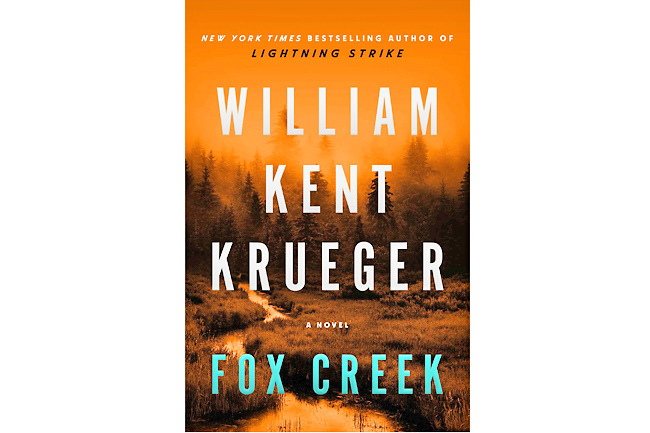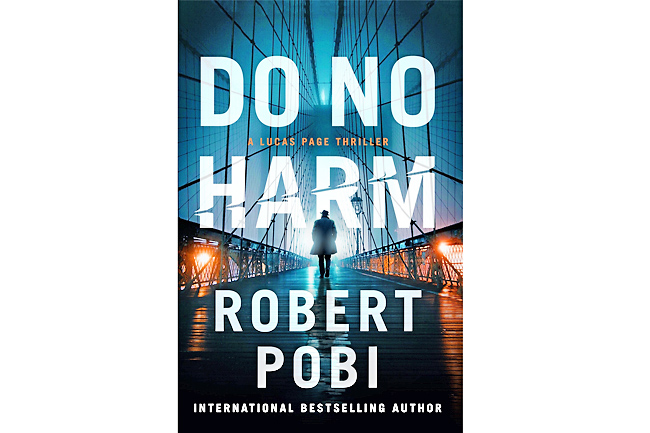Terrified woman tracked through Western wilderness
Bruce DeSilva
AP – Retired sheriff and part time private detective Cork O’Connor is working the grill in his Aurora, Minnesota, restaurant when a stranger wanders in looking for help finding his wife, Delores, who has run off to have an affair with a Native American named Henry Meloux.
Cork agrees to lend a hand, but he sneaks a photo of the stranger because he knows the story is hooey. Fans of William Kent Krueger’s fine series featuring Cork, now in its 19th instalment with the title Fox Creek, know it’s hooey, too. After all, Henry, an Ojibwe healer who’s a regular in these novels, is at least 100 years old.
Cork rushes to Henry’s camp at the edge of the Boundary Waters wilderness and finds that Delores is indeed there. She came seeking Henry’s help with her troubled marriage and with her newfound interest in her native heritage.
There, she’s in the process of getting a cleansing sweat under the guidance of Henry’s great niece Rainy, who is also Cork’s wife.
Dolores confirms that the man in the photo is not her husband, who, it seems, has mysteriously disappeared. So Cork heads back to Aurora to try to figure out what’s going on.
Not long after, Henry senses imminent danger and leads Dolores and Rainy into the wilderness of deep woods and marshes.
When Cork returns to the camp, he finds signs that others have searched the place, and that Dolores, Henry and Rainy are being tracked and hunted, so he heads into the wilderness to track the hunters.
For more than 300 pages, Krueger keeps shifting points of view. We follow Henry as he uses a century of experience as a woodsman to evade the men who are tracking them. We follow a team of mercenaries who are determined to find them, led by a skilled Native American tacker of their own.
And we follow Cork, who grows increasingly fearful that he lacks the skill to save Dolores, Henry and Rainy. It soon becomes evident that not everyone will survive the ordeal in one piece.
Why the mercenaries are hunting Dolores, and how her missing husband figures into the story, remains a mystery until Krueger delivers an unexpected twist at the very end.
As usual in a Krueger novel, the prose is elegant, the landscape of Minnesota’s northeastern triangle is vividly portrayed, the character development is superb, and Henry’s Native American mysticism is treated with understanding and respect.

A twisted pandemic tale
Kiana Doyle
AP – The pandemic has lasted long enough for pandemic-era novels to come out. In Cate Holahan’s thriller, The Darkness of Others,readers are faced with a twisting murder mystery that happens to take place in New York City in the early stages of the COVID-19 pandemic.
After the dead body of acclaimed director Nate Walker is discovered in the opening pages, his wife, Melissa, goes missing, presumably to avoid arrest for murdering him. But Imani Banks, best friend of Melissa, is convinced her friend is innocent.
Raising Imani’s suspicions, Tonya Sayre, a waitress Imani’s chef husband allows into their home after laying her off, turns out to have connections to Nate. Imani determines that it’s only a matter of time until she sleuths out who the real killer is, who may be in her own home.
The Darkness of Others is divided into three parts, the first mainly setting the scene and introducing the characters – perhaps two of the book’s biggest faults.
The setting serves as a reminder of the eerie feelings of the early pandemic. The author puts a thoughtful note at the end about her choice to set the book during the pandemic, but each reference to the early stages is more distracting and painful than the last.
Holahan took a risk with this book, and while it does have its clever moments, the biggest takeaway is that it may still be too soon for some to write a pandemic novel.

A hero struggles with a mystery readers can solve
Bruce DeSilva
AP – Lucas Page retired from the FBI more than a decade ago after losing an eye, an arm, and a leg in an explosion. But Lucas is a man of unique talents, so once again – in Do No Harm, the third book in Robert Pobi’s series – the bureau needs his help.
This time, he is again paired with special agent Alice Whitaker who, because of an incident that occurred in their last case, is walking with a cane. Meanwhile, Page’s upstairs neighbour is a double amputee, and another major character, New York City police detective Johnny Russo, has a glass eye.
The abundance of shredded body parts feels farcical, but Pobi takes a deadly serious tone with the plot, leaving readers uncertain whether to laugh with him or at him.
The plot gets rolling when Lucas, a polymath who can identify patterns in vast collections of data, notices that an inexplicably large number of New York City physicians have been dying. Readers may find it odd that a genius was required to spot this, however.
The deaths have been attributed to a variety of causes including accidents, drug overdoses, and suicide, but Lucas’ statistical analysis concludes that they have been murdered. After launching his investigation, he discovers that a handful of people have been arrested recently for attempting to kill doctors. However, none of them seem to have a motive.
Murder attempts with no motives? What could possibly be going on? Pobi has Lucas puzzle over this until the genius finally tumbles to the obvious on page 266. Anyone who’s seen Alfred Hitchcock’s Strangers on a Train – which includes nearly everyone who reads crime fiction – would have spotted it right off. It’s the old you-do-my-murder-and-I’ll-do-yours trope. However, in the movie there was only one murder. In Do No Harm, it’s happening on a large scale.
Once Lucas figures this out, he spends the rest of the book solving a mystery better suited to his talents: Who has organised a large number of people to trade murders, and why?
Lucas’ utter lack of social skills is oddly endearing, his ability to cope with his physical limitations make him a compelling character, and Pobi is a quirky and talented writer.
However, the author tries too hard to be clever, cluttering his prose with technical names for everyday things and bombarding readers with historical and popular culture references. Within a handful of pages, for example, he throws out references to Ferris Bueller, Albert Speer, Tom Waits, Nietzsche, Harvey Keitel, Zarathustra, and George and Weezie from The Jeffersons. He ought to cut that out.

Detective solves murder of a legendary Chicago cop
Bruce DeSilva
AP – Four veteran Chicago police detectives are known as The Fantastic Four for their long history of spectacular gang busts, so when one of them, Leo Hammond, is shot dead in his bed with his own gun, it’s a big case.
At the start of Joanna Schaffhausen’s Long Gone, the second novel in her new series featuring Detective Annalisa Vega, the young detective is working the scene when Hammond’s three surviving partners show up, demand to take over of the case, and are promptly rebuffed. Like many members of the Chicago Police Department, they don’t trust Vega – not since she busted her own father, a retired member of the department, for covering up a long-ago murder by another family member.
However, the three also have another reason. They need Vega to arrest the obvious suspect and wrap the case up quickly because she’s very good at her job.
If the investigation drags on, she might eventually uncover dark secrets they’ve kept under wraps for years.
The obvious suspect is Hammond’s much younger second wife, who stands to collect on his million-dollar life insurance policy. She was at home during the murder and tells a fantastic story about an intruder dressed in a black wetsuit complete with diving mask and flippers.
However, she is far from the only suspect.
There’s Hammond’s first wife, who despises him, to say nothing of the hundreds of criminals he encountered over a long career. Prominent among them are David Edwards, recently released after serving time for killing a waitress at the sleazy Bass Lounge, and Moe Bocks, who Leo had been harassing ever since failing to prove the guy strangled his girlfriend more than two decades ago.
To make matters worse, Bocks is now dating Vega’s best friend, who refuses to believe warnings that the guy is dangerous.
So, in violation of a direct order, Vega spends as much time perusing Bocks as she does investigating the Hammond murder.
The result is a fast-paced, multi-faceted series of investigations that make Vega a growing threat to the surviving Fantastic Three. In turn, they try to discredit her by framing her for both assault and murder.
Schaffhausen skilfully unwinds her twist-filled plot to a slam-bang conclusion. As with her six previous crime novels, her complex characters are well developed, and her prose, which has improved with each book, is first rate.







